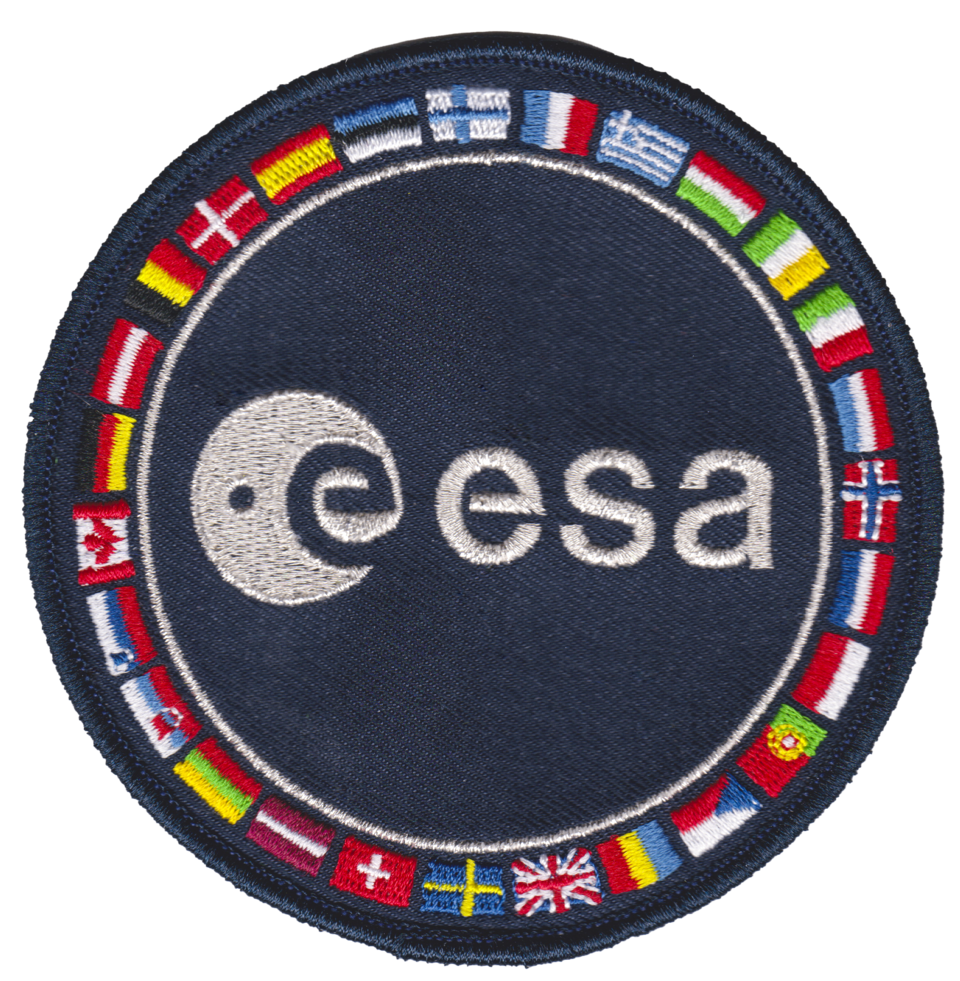And

And

James Webb Infrared Space Telescope annotated, finally launched December 25, 2021, ten years late. Click for more readable view.
6.10.24
GEORGINA TORBET
The Webb and Gaia telescopes have unearthed the early building blocks of the Milky Way.

Webb reveals the Rho Ophiuchi cloud complex, the closest star-forming region to Earth.
In a feat of galactic archeology, astronomers are using ever more detailed information to trace the origin of our galaxy—and to learn about how other galaxies formed in the early stages of the Universe. Using powerful space telescopes like Gaia and Webb, astronomers are able to peer back in time and look at some of the oldest stars and galaxies. Between Gaia’s data on the position and movements of stars within our Milky Way and Webb’s observations of early galaxies that formed when the Universe was still young, astronomers are learning how galaxies come together and have made surprising discoveries that suggest the early Universe was busier and brighter than anyone previously imagined.
The Milky Way’s earliest pieces
In a recent paper [The Astrophysical Journal], researchers using the Gaia space telescope identified two streams of stars, named Shakti and Shiva, each of which contains a total mass of around 10 million Suns and which are thought to have merged into the Milky Way around 12 billion years ago.
These streams were present even before the Milky Way had features like a disk or its spiral arms, and researchers think they could be some of the earliest building blocks of the galaxy as it developed.
“What’s very interesting is that we are able to detect these structures at all from such ancient times,” said lead researcher Khyati Malhan of the Max Planck Institute for Astronomy (MPIA). “These very massive fragments came in and they collapsed under their own gravitational force, and they basically formed the proto Milky Way galaxy.”
This happened when the Universe was still young, with the earliest galaxies forming only around 13 billion years ago. When these groups of stars were coming together to form what would be the Milky Way, it’s debatable whether the group they joined could even have been called a galaxy. While there are broad gravitational requirements for a certain mass of stars to hold itself together, there’s no precise definition of when a group of stars can truly be called the start of a galaxy.
“When is a city a city?” said coauthor Hans-Walter Rix, also of MPIA. “This is why there isn’t an epoch when the galaxy formed. It’s been a continuous process.”
The Milky Way as a test case
With so much still to learn about the formation of galaxies, it makes sense to start with our own Milky Way galaxy as a test case. The Milky Way is “a tremendously average galaxy,” Rix said. When compared to the rest of the Universe, “Half the stars live in bigger galaxies, half the stars live in smaller galaxies.”
What makes the Milky Way useful is that we have unique access to it, providing the ability to see individual stars within it. That means researchers can identify large groups of stars that seem to have originated together with similar ages and levels of heavier elements. Looking at each of these groups lets them track how the galaxy was pieced together.
There are two main ways that stars enter galaxies. In the first, large clouds of diffuse gas are present within an existing galaxy, and this gas condenses so that stars form within it. Alternately, stars that form in a satellite galaxy can be dragged into the main galaxy.
Today, we most often see the formation of stars within gas clouds, with around 90 percent of the stars we see today formed in this way. But at earlier stages of the Universe, the satellite accretion option was much more important, as most stars from this period are thought to have formed in clumps that were then dragged into the young Milky Way.
To understand the Milky Way’s history, astronomers need to trace the origin of these groups of stars and figure out what drew them into the galaxy we know today. “One of the big goals is ‘can we reconstruct the early accretion events of these pieces coming together?’” said Rix.
Using Gaia data, the researchers were able to pick out groups of stars with similar orbits that were located toward the center of the galaxy. They are located about halfway between Earth and the galactic center and are found in a thick-wall torus shape revolving around the galaxy’s center.
The researchers suspect that the two streams of stars they discovered were some of the final pieces of the Milky Way that were absorbed during the satellite accretion stage, after which star formation within the galaxy took over as the primary driver of stars joining the galaxy. “It looks like Shakti and Shiva are perhaps the last hurrah of that early phase, when it was mostly bits and pieces coming together,” Rix said.
Turning back the clock
It is no easy job to trace the clumps of stars that entered the Milky Way billions of years ago. To understand how a galaxy formed, Malhan said, you would ideally want three pieces of information: the orbits of the stars, their ages, and their chemical compositions. For the Milky Way, surveys like Gaia can provide information on the orbits and compositions of stars, but determining stellar ages remains difficult.
So to figure out where stars originate, researchers can look to the stars’ orbits. Once stars join a galaxy, their locations spread, but the ways in which they move tend to be similar. Rather than looking at a particular area of the galaxy and seeing what stars are within it, the researchers plot out the orbits of stars on a grand scale and identify those that share energies and movements.
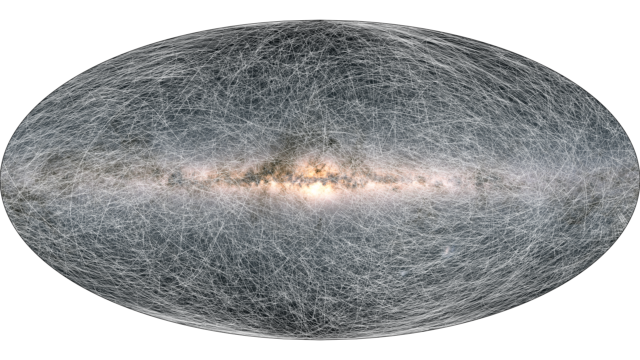
Scientists have used the data from Gaia to track the location and motion of stars in our galaxy. ESA/Gaia/DPAC
They can also look for telltale signs of older stars by studying their composition. In the very earliest stages of the Universe, the vast majority of all matter was hydrogen and helium. The heavier elements like metals were produced within the cores of the first stars as they underwent fusion; when these stars exploded in supernovae, they spread those metals out and into the Universe.
So, a star that is low in heavy elements (in astronomical terms, it has low metallicity) is an old one. As the Universe evolved, more stars became “polluted” by metals. This is how a star’s composition can indicate its age and why low-metallicity stars are of such interest to those studying the early stages of the galaxy.
“So galaxy evolution is also the history of galactic self-pollution,” Rix said. “And at some level, one can sort stars according to age by the ones that are less polluted or chemically more pristine, which we call metal-poor. They are the old ones. And Gaia has allowed us to actually determine orbits for all these stars.”
Determining exact stellar ages
Looking at a star’s metallicity is a good indicator of its rough age, but to be more precise, researchers search for more detailed information. One indicator that has been useful in studying the Milky Way is looking at other aspects of their composition, such as the preponderance of what are called alpha elements, which can indicate how quickly a star formed. (An alpha particle is another term for the helium nucleus, which fuses to form these elements.)
Due to the nature of the fusion process, long-lived stars produce more iron, while short-lived stars produce more calcium and magnesium, called alpha elements. So there is rapid self-pollution of alpha elements but a more gradual self-pollution of iron. If a high alpha star is identified, that means it formed rapidly. The Shakti and Shiva streams are made up almost entirely of high-alpha, low-metallicity stars. That helps group them as both being very old and having formed around the same time.
Even with this data, however, the measurements of stellar ages are still imprecise. “One is still stuck with using these element ratios as chemical clocks to make qualitative arguments about the age sequence,” Rix said. “Ideally, we’d like to just measure the ages of these stars. There’s the prospect with the next round of Gaia to do this, but we can’t do this yet.”
With the next release of data from Gaia in 2026, there will be a wealth of new information on the ages of stars within the Milky Way. There are stars that have a known relationship between their age and their luminosity, so if this luminosity can be precisely measured, their age can be calculated. These stars are faint and hard to detect, but they’ll be included in the next batch of Gaia data. This will enable exciting new areas of research, but it will still be constrained by uncertainties regarding ages.
“We are now getting better at determining the ages of stars to within 10 percent,” Rix said. “But that still means that 11 billion years old and 13 billion years old are barely distinguishable.”
That’s a not-insignificant problem, and even with newer Gaia data, it will still be impossible to know exactly how old a given star is.
So some astronomers take another approach to understanding the formation of the Milky Way: looking beyond our own galaxy and into the Universe, searching for similar galaxies at an earlier stage of formation.
With Webb astronomers have the opportunity to see these distant galaxies in more detail than ever before, allowing them to be examined as models for what the Milky Way could have looked like millions of years ago.
“We have the possibility to test any scenario we concoct for the Milky Way by asking, then let’s envision what the Milky Way would have looked like at redshift 5, 6, or 7,” Rix said. “Which now we can actually see,” thanks to Webb.
Webb’s view of the early universe
Webb’s observations come with their own challenges, though. Determining the age of a galaxy is not a simple matter, even using a powerful tool, for reasons that have as much to do with definitions as with available data.
“How do you define the age of a galaxy? Is it the first time it formed or the most recent set of star formation? We’re talking about an ensemble of objects, all of which are going to have different ages,” said Micaela Bagley of the University of Texas at Austin, a researcher on Webb’s CEERS (Cosmic Evolution Early Release Science Survey) project. CEERS has identified some of the oldest galaxies ever seen, at redshifts of up to 12, which corresponds to as early as just 500 million years after the Big Bang.
These galaxies observed by Webb are too far away to resolve individual stars, so its instruments collect data on the galaxies as a whole. Using cameras like NIRCam [below], Webb observes many of these distant galaxies as a cluster of pixels, but using its spectroscopy instruments like NIRSpec [below], it can obtain more detailed data, like signatures of recent or older star formation.
The very distant galaxies observed so far, which are part of the early Universe, are typically showing very active, very recent star formation. Webb can’t track the age of individual stars or groups of stars, but it can look at a galaxy’s history of star formation as a whole—whether a galaxy has had multiple periods of star formation or whether its star formation spiked and then declined, for example.
With these early galaxies, “We’re looking at their populations of stars to try to figure out the history of their star formation,” Bagley explained. “Not necessarily how old it is but how it has gone about its life.”
Early evidence suggests that galaxies have typically experienced star formation in waves, peaking and troughing over time. But all that active star formation at such an early stage in the Universe poses some problems.
A brighter early universe
Early results from Webb have been exciting for many reasons, but astronomers are particularly intrigued to learn that the early Universe is not quite as we imagined it to be. From almost the first week that Webb began its science operations, it has been turning up brighter and more massive galaxies much earlier than anyone expected, and subsequent observations have backed these findings up.
When it comes to galaxies in the early Universe, “Across the board, everything is more,” Bagley said. Webb has found early galaxies that are brighter and more numerous than predicted, and these galaxies have developed in unexpected ways: “There are more black holes than we thought, and there are more dusty galaxies than we thought. These galaxies are able to form dust, which should take a long time, but they’re doing it earlier and more efficiently than we thought.”
The early Universe “is just a much busier place than we thought,” Bagley summed up.
As part of this busy development, galaxies have been found with structures similar to the Milky Way much earlier than had been expected as well. The very earliest galaxies observed by Webb, at around 12 or 13 billion years old, tend to be diffuse and chaotic, with not much structure. But structured galaxies with features like disks, spiral arms, or bars have been found as far back as around 11 billion years (z≈3), far earlier than predicted.
“We thought that it would take a very long time to form a galaxy that was gravitationally stable enough to have a disk and spiral arms like the Milky Way does. But we’re starting to see some of those pretty early in the Universe. Not as early as the first galaxies, but way earlier than we expected,” Bagley said.
Even galaxies from just a few hundred million years after the Big Bang (redshifts of 7 and above), which had previously been only observed by Hubble as blobs of light, seem to be being resolved by Webb as having some kind of structure.
“Galaxies seem to be forming very quickly, then reaching that equilibrium that allows them to rotate and flatten into a disk. And once you’re in that shape, you can start to have structures form, like spiral arms,” Bagley explained.
Simulating the universe
As exciting as these discoveries are, they are proving hard to reconcile with models of galaxy formation we have now. Researchers typically plot out the story of galaxy formation using simulations, aiming to model the presence of features like stars and dark matter and seeing how those interact. Right now, however, none of these simulations exactly match what is seen in the Universe across time.
Given the preponderance of stars and galaxies observed by Webb in the early Universe, the mechanisms of star formation in these simulations need to be made more efficient.
In short, there needs to be some explanation of where all these extra stars are coming from—whether it’s because the early Universe was denser than expected and denser galaxies encouraged faster star formation, because the proportion of massive stars to smaller stars being formed is different, or even because the amount of dust present in early galaxies is different, and that makes the stars appear to shine brighter.
It’s not currently known what the best explanation for the prevalence of bright, earlier galaxies is. Though it’s easy enough to tweak a simulation to make it match the possible theories, the problem is that the simulation then over-predicts what is observed today. If a simulation accurately models the efficient star formation seen in the earliest galaxies at redshift 12 or 13, by the time it gets to redshift 7 or so, it is showing more or brighter galaxies than we observe.
“Getting the story correct across the full history of the Universe is really challenging and is probably going to require a lot more observations,” Bagley said. “It’s exciting that we still don’t understand it.”
See the full article here .
Comments are invited and will be appreciated, especially if the reader finds any errors which I can correct.
five-ways-keep-your-child-safe-school-shootings
Please help promote STEM in your local schools.
Webb is a large infrared telescope with a 6.5-meter primary mirror. Webb was finally launched December 25, 2021, ten years late. Webb will be the premier observatory of the next decade, serving thousands of astronomers worldwide. It will study every phase in the history of our Universe, ranging from the first luminous glows after the Big Bang, to the formation of solar systems capable of supporting life on planets like Earth, to the evolution of our own Solar System.
Webb is the world’s largest, most powerful, and most complex space science telescope ever built. Webb will solve mysteries in our solar system, look beyond to distant worlds around other stars, and probe the mysterious structures and origins of our universe and our place in it.
Webb was formerly known as the “Next Generation Space Telescope” (NGST); it was renamed in Sept. 2002 after a former NASA administrator, James Webb.
Webb is an international collaboration between National Aeronautics and Space Administration, the European Space Agency (ESA), and the Canadian Space Agency (CSA). The NASA Goddard Space Flight Center managed the development effort. The main industrial partner is Northrop Grumman; the Space Telescope Science Institute operates Webb.
Several innovative technologies have been developed for Webb. These include a folding, segmented primary mirror, adjusted to shape after launch; ultra-lightweight beryllium optics; detectors able to record extremely weak signals, microshutters that enable programmable object selection for the spectrograph; and a cryocooler for cooling the mid-IR detectors to 7K.
There are four science instruments on Webb: The Near InfraRed Camera (NIRCam), The Near InfraRed Spectrograph (NIRspec), The Mid-InfraRed Instrument (MIRI), and The Fine Guidance Sensor/ Near InfraRed Imager and Slitless Spectrograph (FGS-NIRISS).
Webb’s instruments are designed to work primarily in the infrared range of the electromagnetic spectrum, with some capability in the visible range. It will be sensitive to light from 0.6 to 28 micrometers in wavelength.




Webb has four main science themes: The End of the Dark Ages: First Light and Reionization, The Assembly of Galaxies, The Birth of Stars and Protoplanetary Systems, and Planetary Systems and the Origins of Life.
Launch was December 25, 2021, ten years late, on an Ariane 5 rocket. The launch was from Arianespace’s ELA-3 launch complex at European Spaceport located near Kourou, French Guiana. Webb is located at the second Lagrange point, about a million miles from the Earth.

Objective
A global space astrometry mission, Gaia will make the largest, most precise three-dimensional map of our Galaxy by surveying more than a thousand million stars.
Mission
Gaia will monitor each of its target stars about 70 times over a five-year period. It will precisely chart their positions, distances, movements, and changes in brightness. It is expected to discover hundreds of thousands of new celestial objects, such as extra-solar planets and brown dwarfs, and observe hundreds of thousands of asteroids within our own Solar System. The mission will also study about 500 000 distant quasars and will provide stringent new tests of Albert Einstein’s General Theory of Relativity.
Gaia will create an extraordinarily precise three-dimensional map of more than a thousand million stars throughout our Galaxy and beyond, mapping their motions, luminosity, temperature and composition. This huge stellar census will provide the data needed to tackle an enormous range of important problems related to the origin, structure and evolutionary history of our Galaxy.
For example, Gaia will identify which stars are relics from smaller galaxies long ago ‘swallowed’ by the Milky Way. By watching for the large-scale motion of stars in our Galaxy, it will also probe the distribution of dark matter, the invisible substance thought to hold our Galaxy together.
Gaia will achieve its goals by repeatedly measuring the positions of all objects down to magnitude 20 (about 400 000 times fainter than can be seen with the naked eye).
For all objects brighter than magnitude 15 (4000 times fainter than the naked eye limit), Gaia will measure their positions to an accuracy of 24 microarcseconds. This is comparable to measuring the diameter of a human hair at a distance of 1000 km.
It will allow the nearest stars to have their distances measured to the extraordinary accuracy of 0.001%. Even stars near the Galactic centre, some 30 000 light-years away, will have their distances measured to within an accuracy of 20%.
The vast catalogue of celestial objects expected from Gaia’s scientific haul will not only benefit studies of our own Solar System and Galaxy, but also the fundamental physics that underpins our entire Universe.
The European Space Agency [La Agencia Espacial Europea] [Agence spatiale européenne][Europäische Weltraumorganization](EU), established in 1975, is an intergovernmental organization dedicated to the exploration of space, currently with 19 member states. Headquartered in Paris, ESA has a staff of more than 2,000. ESA’s space flight program includes human spaceflight, mainly through the participation in the International Space Station program, the launch and operations of unmanned exploration missions to other planets and the Moon, Earth observation, science, telecommunication as well as maintaining a major spaceport, the Guiana Space Centre at Kourou, French Guiana, and designing launch vehicles. ESA science missions are based at ESTEC (NL) in Noordwijk, Netherlands, Earth Observation missions at ESRIN in Frascati, Italy, ESA Mission Control (ESOC) is in Darmstadt, Germany, the European Astronaut Centre (EAC) that trains astronauts for future missions is situated in Cologne, Germany, and the
European Space Astronomy Centre is located in Villanueva de la Cañada, Spain.

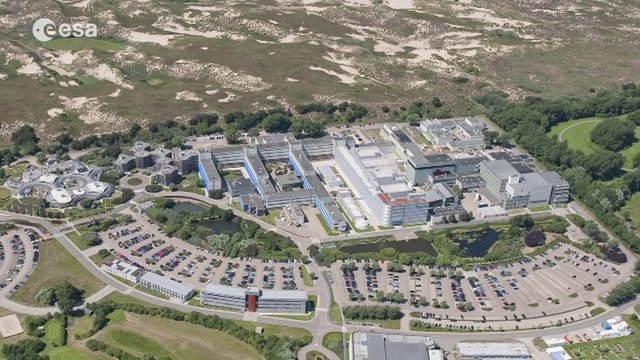 The European Space Agency [La Agencia Espacial Europea] [Agence spatiale européenne][Europäische Weltraumorganization](EU) Estec, situated in Noordwijk, South Holland, in the western Netherlands.
The European Space Agency [La Agencia Espacial Europea] [Agence spatiale européenne][Europäische Weltraumorganization](EU) Estec, situated in Noordwijk, South Holland, in the western Netherlands.

ESA’s space flight programme includes human spaceflight (mainly through participation in the International Space Station program); the launch and operation of uncrewed exploration missions to other planets and the Moon; Earth observation, science and telecommunication; designing launch vehicles; and maintaining a major spaceport, the The Guiana Space Centre [Centre Spatial Guyanais; CSG also called Europe’s Spaceport) at Kourou, French Guiana. The main European launch vehicle Ariane 5 is operated through Arianespace with ESA sharing in the costs of launching and further developing this launch vehicle. The agency is also working with The National Aeronautics and Space Agency to manufacture the Orion Spacecraft service module that will fly on the Space Launch System.
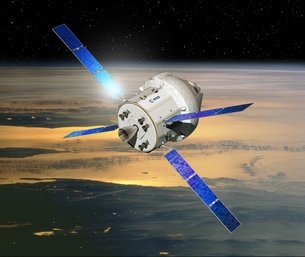



The agency’s facilities are distributed among the following centres:
ESA European Space Research and Technology Centre (ESTEC) (NL) in Noordwijk, Netherlands;
ESA Centre for Earth Observation [ESRIN] (IT) in Frascati, Italy;
ESA Mission Control ESA European Space Operations Center [ESOC](DE) is in Darmstadt, Germany;
ESA -European Astronaut Centre [EAC] trains astronauts for future missions is situated in Cologne, Germany;
European Centre for Space Applications and Telecommunications (ECSAT) (UK), a research institute created in 2009, is located in Harwell, England;
ESA – European Space Astronomy Centre [ESAC] (ES) is located in Villanueva de la Cañada, Madrid, Spain.
European Space Agency Science Programme is a long-term programme of space science and space exploration missions.
Foundation
After World War II, many European scientists left Western Europe in order to work with the United States. Although the 1950s boom made it possible for Western European countries to invest in research and specifically in space-related activities, Western European scientists realized solely national projects would not be able to compete with the two main superpowers. In 1958, only months after the Sputnik shock, Edoardo Amaldi (Italy) and Pierre Auger (France), two prominent members of the Western European scientific community, met to discuss the foundation of a common Western European space agency. The meeting was attended by scientific representatives from eight countries, including Harrie Massey (United Kingdom).
The Western European nations decided to have two agencies: one concerned with developing a launch system, ELDO (European Launch Development Organization) , and the other the precursor of the European Space Agency, ESRO (European Space Research Organization) . The latter was established on 20 March 1964 by an agreement signed on 14 June 1962. From 1968 to 1972, ESRO launched seven research satellites.
ESA in its current form was founded with the ESA Convention in 1975, when ESRO was merged with ELDO. ESA had ten founding member states: Belgium, Denmark, France, West Germany, Italy, the Netherlands, Spain, Sweden, Switzerland, and the United Kingdom. These signed the ESA Convention in 1975 and deposited the instruments of ratification by 1980, when the convention came into force. During this interval the agency functioned in a de facto fashion. ESA launched its first major scientific mission in 1975, Cos-B, a space probe monitoring gamma-ray emissions in the universe, which was first worked on by ESRO.
Later activities



The European Space Agency [La Agencia Espacial Europea] [Agence spatiale européenne][Europäische Weltraumorganization](EU) Copernicus mission.











ESA collaborated with National Aeronautics Space Agency on the International Ultraviolet Explorer (IUE), the world’s first high-orbit telescope, which was launched in 1978 and operated successfully for 18 years.







A number of successful Earth-orbit projects followed, and in 1986 ESA began Giotto, its first deep-space mission, to study the comets Halley and Grigg–Skjellerup. Hipparcos, a star-mapping mission, was launched in 1989 and in the 1990s SOHO, Ulysses and the Hubble Space Telescope were all jointly carried out with NASA. Later scientific missions in cooperation with NASA include the Cassini–Huygens space probe, to which ESA contributed by building the Titan landing module Huygens.

As the successor of ELDO, ESA has also constructed rockets for scientific and commercial payloads. Ariane 1, launched in 1979, carried mostly commercial payloads into orbit from 1984 onward. The next two versions of the Ariane rocket were intermediate stages in the development of a more advanced launch system, the Ariane 4, which operated between 1988 and 2003 and established ESA as the world leader in commercial space launches in the 1990s. Although the succeeding Ariane 5 experienced a failure on its first flight, it has since firmly established itself within the heavily competitive commercial space launch market with 82 successful launches until 2018. The successor launch vehicle of Ariane 5, the Ariane 6, is under development and is envisioned to enter service in the 2020s.
The beginning of the new millennium saw ESA become, along with agencies like National Aeronautics Space Agency, Japan Aerospace Exploration Agency (JP), Indian Space Research Organization (IN), the Canadian Space Agency(CA) and Roscosmos (RU), one of the major participants in scientific space research. Although ESA had relied on co-operation with NASA in previous decades, especially the 1990s, changed circumstances (such as tough legal restrictions on information sharing by the United States military) led to decisions to rely more on itself and on co-operation with Russia. A 2011 press issue thus stated:
“Russia is ESA’s first partner in its efforts to ensure long-term access to space. There is a framework agreement between ESA and the government of the Russian Federation on cooperation and partnership in the exploration and use of outer space for peaceful purposes, and cooperation is already underway in two different areas of launcher activity that will bring benefits to both partners.”
Notable ESA programs include SMART-1, a probe testing cutting-edge space propulsion technology, the Mars Express and Venus Express missions, as well as the development of the Ariane 5 rocket and its role in the ISS partnership. ESA maintains its scientific and research projects mainly for astronomy-space missions such as Corot, launched on 27 December 2006, a milestone in the search for exoplanets.
On 21 January 2019, ArianeGroup and Arianespace announced a one-year contract with ESA to study and prepare for a mission to mine the Moon for lunar regolith.
Mission
The treaty establishing the European Space Agency reads:
The purpose of the Agency shall be to provide for and to promote, for exclusively peaceful purposes, cooperation among European States in space research and technology and their space applications, with a view to their being used for scientific purposes and for operational space applications systems…
ESA is responsible for setting a unified space and related industrial policy, recommending space objectives to the member states, and integrating national programs like satellite development, into the European program as much as possible.
Jean-Jacques Dordain – ESA’s Director General (2003–2015) – outlined the European Space Agency’s mission in a 2003 interview:
“Today space activities have pursued the benefit of citizens, and citizens are asking for a better quality of life on Earth. They want greater security and economic wealth, but they also want to pursue their dreams, to increase their knowledge, and they want younger people to be attracted to the pursuit of science and technology. I think that space can do all of this: it can produce a higher quality of life, better security, more economic wealth, and also fulfill our citizens’ dreams and thirst for knowledge, and attract the young generation. This is the reason space exploration is an integral part of overall space activities. It has always been so, and it will be even more important in the future.”
Activities
According to the ESA website, the activities are:
Observing the Earth
Human Spaceflight
Launchers
Navigation
Space Science
Space Engineering & Technology
Operations
Telecommunications & Integrated Applications
Preparing for the Future
Space for Climate
Programs
Copernicus Programme
Cosmic Vision
ExoMars
FAST20XX
Galileo
Horizon 2000
Living Planet Programme
Mandatory
Every member country must contribute to these programs:
Technology Development Element Program
Science Core Technology Program
General Study Program
European Component Initiative
Optional
Depending on their individual choices the countries can contribute to the following programs, listed according to:
Launchers
Earth Observation
Human Spaceflight and Exploration
Telecommunications
Navigation
Space Situational Awareness
Technology
ESA_LAB@
ESA has formed partnerships with universities. ESA_LAB@ refers to research laboratories at universities. Currently there are ESA_LAB@
Technische Universität Darmstadt (DE)
École des hautes études commerciales de Paris (HEC Paris) (FR)
Université de recherche Paris Sciences et Lettres (FR)
The University of Central Lancashire (UK)
Membership and contribution to ESA
By 2015, ESA was an intergovernmental organization of 22 member states. Member states participate to varying degrees in the mandatory (25% of total expenditures in 2008) and optional space programs (75% of total expenditures in 2008). The 2008 budget amounted to €3.0 billion whilst the 2009 budget amounted to €3.6 billion. The total budget amounted to about €3.7 billion in 2010, €3.99 billion in 2011, €4.02 billion in 2012, €4.28 billion in 2013, €4.10 billion in 2014 and €4.33 billion in 2015. English is the main language within ESA. Additionally, official documents are also provided in German and documents regarding the Spacelab are also provided in Italian. If found appropriate, the agency may conduct its correspondence in any language of a member state.
Non-full member states
Slovenia
Since 2016, Slovenia has been an associated member of the ESA.
Latvia
Latvia became the second current associated member on 30 June 2020, when the Association Agreement was signed by ESA Director Jan Wörner and the Minister of Education and Science of Latvia, Ilga Šuplinska in Riga. The Saeima ratified it on July 27. Previously associated members were Austria, Norway and Finland, all of which later joined ESA as full members.
Canada
Since 1 January 1979, Canada has had the special status of a Cooperating State within ESA. By virtue of this accord, The Canadian Space Agency [Agence spatiale canadienne, ASC] (CA) takes part in ESA’s deliberative bodies and decision-making and also in ESA’s programs and activities. Canadian firms can bid for and receive contracts to work on programs. The accord has a provision ensuring a fair industrial return to Canada. Canada has continually increased its annual contribution.
Enlargement
After the decision of the ESA Council of 21/22 March 2001, the procedure for accession of the European states was detailed as described the document titled The Plan for European Co-operating States (PECS). Nations that want to become a full member of ESA do so in 3 stages. First a Cooperation Agreement is signed between the country and ESA. In this stage, the country has very limited financial responsibilities. If a country wants to co-operate more fully with ESA, it signs a European Cooperating State (ECS) Agreement. The ECS Agreement makes companies based in the country eligible for participation in ESA procurements. The country can also participate in all ESA programs, except for the Basic Technology Research Programme. While the financial contribution of the country concerned increases, it is still much lower than that of a full member state. The agreement is normally followed by a Plan For European Cooperating State (or PECS Charter). This is a 5-year programme of basic research and development activities aimed at improving the nation’s space industry capacity. At the end of the 5-year period, the country can either begin negotiations to become a full member state or an associated state or sign a new PECS Charter.
During the Ministerial Meeting in December 2014, ESA ministers approved a resolution calling for discussions to begin with Israel, Australia and South Africa on future association agreements. The ministers noted that “concrete cooperation is at an advanced stage” with these nations and that “prospects for mutual benefits are existing”.
A separate space exploration strategy resolution calls for further co-operation with the United States, Russia and China on “LEO” exploration, including a continuation of ISS cooperation and the development of a robust plan for the coordinated use of space transportation vehicles and systems for exploration purposes, participation in robotic missions for the exploration of the Moon, the robotic exploration of Mars, leading to a broad Mars Sample Return mission in which Europe should be involved as a full partner, and human missions beyond LEO in the longer term.”
Relationship with the European Union
The political perspective of the European Union (EU) was to make ESA an agency of the EU. The EU member states provide most of ESA’s funding, and they are all either full ESA members or observers.
History
At the time ESA was formed, its main goals did not encompass human space flight; rather it considered itself to be primarily a scientific research organization for uncrewed space exploration in contrast to its American and Soviet counterparts. It is therefore not surprising that the first non-Soviet European in space was not an ESA astronaut on a European space craft; it was Czechoslovak Vladimír Remek who in 1978 became the first non-Soviet or American in space (the first man in space being Yuri Gagarin of the Soviet Union) – on a Soviet Soyuz spacecraft, followed by the Pole Mirosław Hermaszewski and East German Sigmund Jähn in the same year. This Soviet co-operation programme, known as Intercosmos, primarily involved the participation of Eastern bloc countries. In 1982, however, Jean-Loup Chrétien became the first non-Communist Bloc astronaut on a flight to the Soviet Salyut 7 space station.
Because Chrétien did not officially fly into space as an ESA astronaut, but rather as a member of the French CNES astronaut corps, the German Ulf Merbold is considered the first ESA astronaut to fly into space. He participated in the STS-9 Space Shuttle mission that included the first use of the European-built Spacelab in 1983. STS-9 marked the beginning of an extensive ESA/NASA joint partnership that included dozens of space flights of ESA astronauts in the following years. Some of these missions with Spacelab were fully funded and organizationally and scientifically controlled by ESA (such as two missions by Germany and one by Japan) with European astronauts as full crew members rather than guests on board. Beside paying for Spacelab flights and seats on the shuttles, ESA continued its human space flight co-operation with the Soviet Union and later Russia, including numerous visits to Mir.
During the latter half of the 1980s, European human space flights changed from being the exception to routine and therefore, in 1990, the European Astronaut Centre in Cologne, Germany was established. It selects and trains prospective astronauts and is responsible for the co-ordination with international partners, especially with regard to the International Space Station. As of 2006, the ESA astronaut corps officially included twelve members, including nationals from most large European countries except the United Kingdom.
In the summer of 2008, ESA started to recruit new astronauts so that final selection would be due in spring 2009. Almost 10,000 people registered as astronaut candidates before registration ended in June 2008. Over 8,000 fulfilled the initial application criteria. Of the applicants, over 900 were chosen to take part in the first stage of psychological testing, which narrowed down the field to 200. After two-stage psychological tests and medical evaluation in early 2009, as well as formal interviews, six new members of the European Astronaut Corps were selected – five men and one woman.
Cooperation with other countries and organizations
ESA has signed co-operation agreements with the following states that currently neither plan to integrate as tightly with ESA institutions as Canada, nor envision future membership of ESA: Argentina, Brazil, China, India (for the Chandrayan mission), Russia and Turkey.
Additionally, ESA has joint projects with the European Union, NASA of the United States and is participating in the International Space Station together with the United States (NASA), Russia and Japan (JAXA).
European Union
ESA and EU member states
ESA-only members
EU-only members
ESA is not an agency or body of the European Union (EU), and has non-EU countries (Norway, Switzerland, and the United Kingdom) as members. There are however ties between the two, with various agreements in place and being worked on, to define the legal status of ESA with regard to the EU.
There are common goals between ESA and the EU. ESA has an EU liaison office in Brussels. On certain projects, the EU and ESA co-operate, such as the upcoming Galileo satellite navigation system. Space policy has since December 2009 been an area for voting in the European Council. Under the European Space Policy of 2007, the EU, ESA and its Member States committed themselves to increasing co-ordination of their activities and programs and to organizing their respective roles relating to space.
The Lisbon Treaty of 2009 reinforces the case for space in Europe and strengthens the role of ESA as an R&D space agency. Article 189 of the Treaty gives the EU a mandate to elaborate a European space policy and take related measures, and provides that the EU should establish appropriate relations with ESA.
Former Italian astronaut Umberto Guidoni, during his tenure as a Member of the European Parliament from 2004 to 2009, stressed the importance of the European Union as a driving force for space exploration, “…since other players are coming up such as India and China it is becoming ever more important that Europeans can have an independent access to space. We have to invest more into space research and technology in order to have an industry capable of competing with other international players.”
The first EU-ESA International Conference on Human Space Exploration took place in Prague on 22 and 23 October 2009. A road map which would lead to a common vision and strategic planning in the area of space exploration was discussed. Ministers from all 29 EU and ESA members as well as members of parliament were in attendance.
National space organizations of member states:
The Centre National d’Études Spatiales(FR) (CNES) (National Centre for Space Study) is the French government space agency (administratively, a “public establishment of industrial and commercial character”). Its headquarters are in central Paris. CNES is the main participant on the Ariane project. Indeed, CNES designed and tested all Ariane family rockets (mainly from its centre in Évry near Paris)
The UK Space Agency is a partnership of the UK government departments which are active in space. Through the UK Space Agency, the partners provide delegates to represent the UK on the various ESA governing bodies. Each partner funds its own programme.
The Italian Space Agency A.S.I. – Agenzia Spaziale Italiana was founded in 1988 to promote, co-ordinate and conduct space activities in Italy. Operating under the Ministry of the Universities and of Scientific and Technological Research, the agency cooperates with numerous entities active in space technology and with the president of the Council of Ministers. Internationally, the ASI provides Italy’s delegation to the Council of the European Space Agency and to its subordinate bodies.
The German Aerospace Center (DLR)[Deutsches Zentrum für Luft- und Raumfahrt e. V.] is the national research centre for aviation and space flight of the Federal Republic of Germany and of other member states in the Helmholtz Association. Its extensive research and development projects are included in national and international cooperative programs. In addition to its research projects, the centre is the assigned space agency of Germany bestowing headquarters of German space flight activities and its associates.
The Instituto Nacional de Técnica Aeroespacial (INTA)(ES) (National Institute for Aerospace Technique) is a Public Research Organization specialized in aerospace research and technology development in Spain. Among other functions, it serves as a platform for space research and acts as a significant testing facility for the aeronautic and space sector in the country.
National Aeronautics Space Agency
ESA has a long history of collaboration with NASA. Since ESA’s astronaut corps was formed, the Space Shuttle has been the primary launch vehicle used by ESA’s astronauts to get into space through partnership programs with NASA. In the 1980s and 1990s, the Spacelab programme was an ESA-NASA joint research programme that had ESA develop and manufacture orbital labs for the Space Shuttle for several flights on which ESA participate with astronauts in experiments.
In robotic science mission and exploration missions, NASA has been ESA’s main partner. Cassini–Huygens was a joint NASA-ESA mission, along with the Infrared Space Observatory, INTEGRAL, SOHO, and others.



Also, the Hubble Space Telescope is a joint project of NASA and ESA.
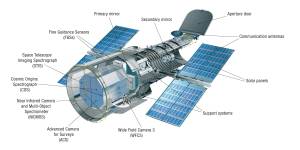
ESA-NASA joint projects include the James Webb Space Telescope and the proposed Laser Interferometer Space Antenna.

____________________
ESA/NASA eLISA space based gravitational wave hunter system




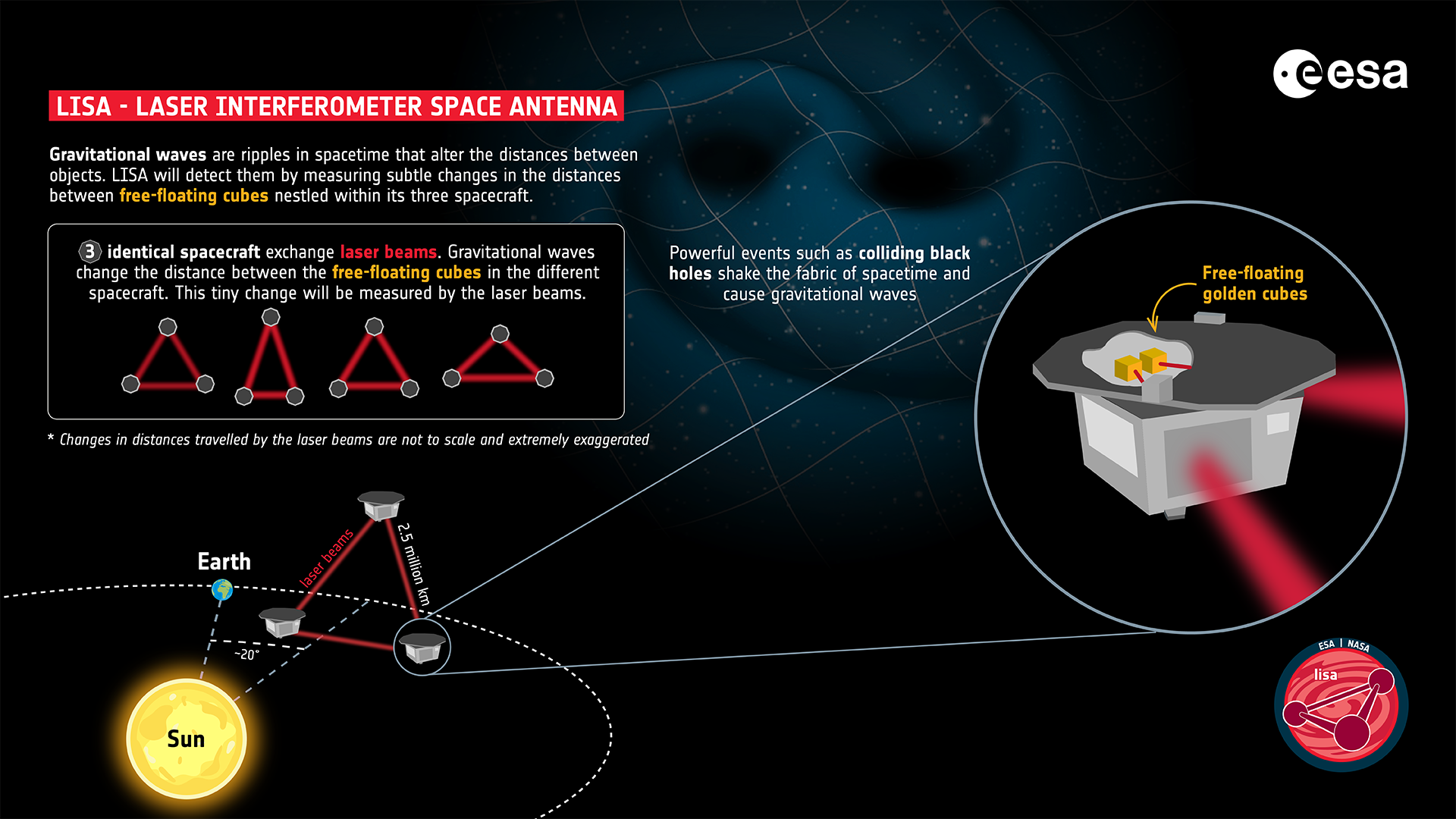
LISA – measuring gravitational waves.
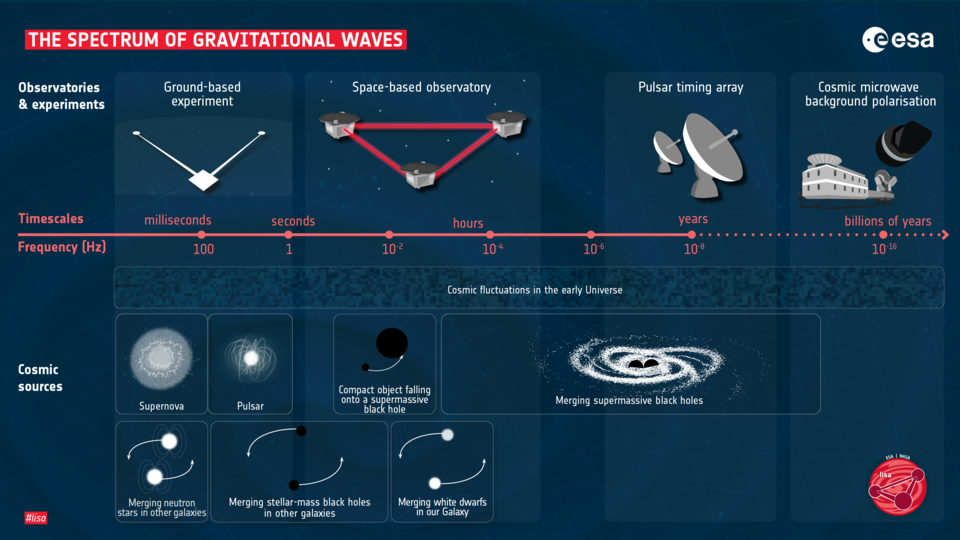
The spectrum of gravitational waves
____________________
NASA has committed to provide support to ESA’s proposed MarcoPolo-R mission to return an asteroid sample to Earth for further analysis. NASA and ESA will also likely join together for a Mars Sample Return Mission. In October 2020 the ESA entered into a memorandum of understanding (MOU) with NASA to work together on the Artemis program, which will provide an orbiting lunar gateway and also accomplish the first manned lunar landing in 50 years, whose team will include the first woman on the Moon.

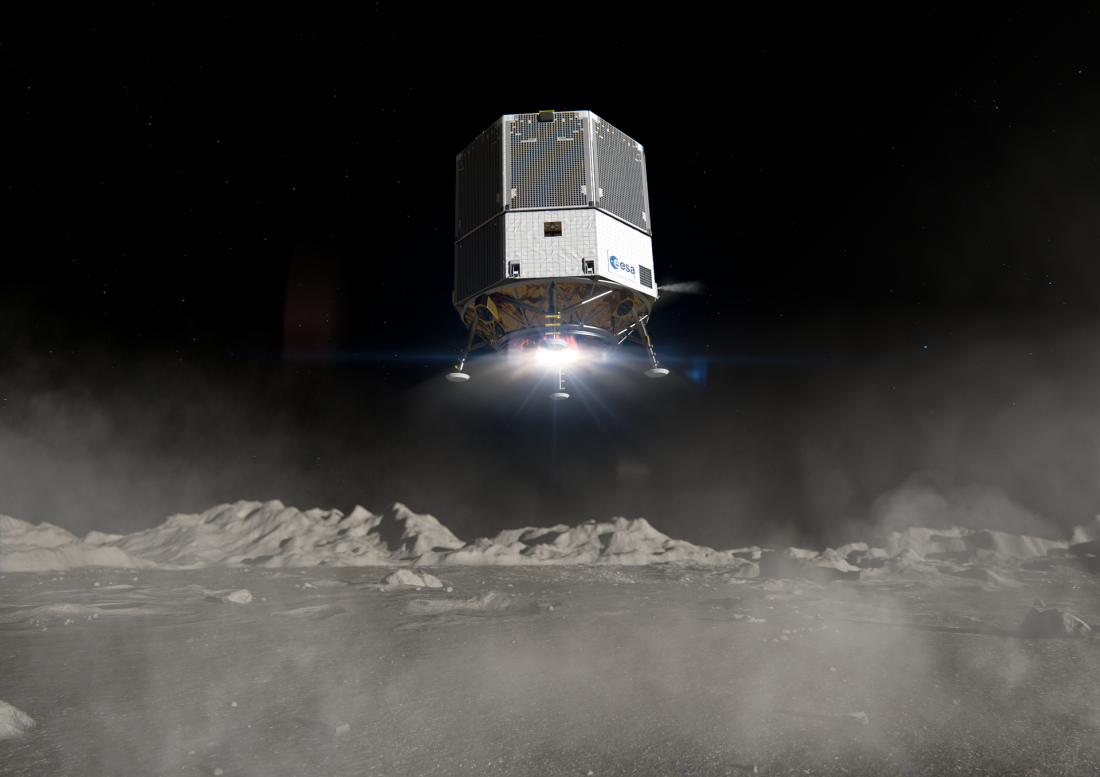
Cooperation with other space agencies
Since China has started to invest more money into space activities, the Chinese Space Agency[中国国家航天局] (CN) has sought international partnerships. ESA is, beside, The Russian Federal Space Agency Государственная корпорация по космической деятельности «Роскосмос»](RU) one of its most important partners. Two space agencies cooperated in the development of the Double Star Mission. In 2017, ESA sent two astronauts to China for two weeks sea survival training with Chinese astronauts in Yantai, Shandong.
ESA entered into a major joint venture with Russia in the form of the CSTS, the preparation of French Guiana spaceport for launches of Soyuz-2 rockets and other projects. With India, ESA agreed to send instruments into space aboard the ISRO’s Chandrayaan-1 in 2008. ESA is also co-operating with Japan, the most notable current project in collaboration with JAXA is the BepiColombo mission to Mercury.

ESA’s Mercury Planetary Orbiter (MPO) will be operated from ESOC Germany.
Speaking to reporters at an air show near Moscow in August 2011, ESA head Jean-Jacques Dordain said ESA and Russia’s Roskosmos space agency would “carry out the first flight to Mars together.”

For the future







Ars Technica was founded in 1998 when Founder & Editor-in-Chief Ken Fisher announced his plans for starting a publication devoted to technology that would cater to what he called “alpha geeks”: technologists and IT professionals. Ken’s vision was to build a publication with a simple editorial mission: be “technically savvy, up-to-date, and more fun” than what was currently popular in the space. In the ensuing years, with formidable contributions by a unique editorial staff, Ars Technica became a trusted source for technology news, tech policy analysis, breakdowns of the latest scientific advancements, gadget reviews, software, hardware, and nearly everything else found in between layers of silicon.
Ars Technica innovates by listening to its core readership. Readers have come to demand devotedness to accuracy and integrity, flanked by a willingness to leave each day’s meaningless, click-bait fodder by the wayside. The result is something unique: the unparalleled marriage of breadth and depth in technology journalism. By 2001, Ars Technica was regularly producing news reports, op-eds, and the like, but the company stood out from the competition by regularly providing long thought-pieces and in-depth explainers.
And thanks to its readership, Ars Technica also accomplished a number of industry leading moves. In 2001, Ars launched a digital subscription service when such things were non-existent for digital media. Ars was also the first IT publication to begin covering the resurgence of Apple, and the first to draw analytical and cultural ties between the world of high technology and gaming. Ars was also first to begin selling its long form content in digitally distributable forms, such as PDFs and eventually eBooks (again, starting in 2001).







